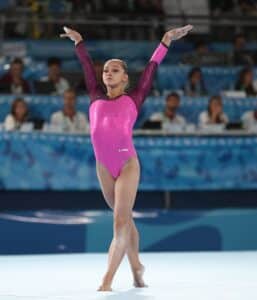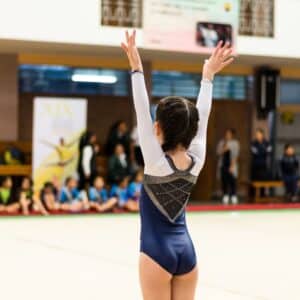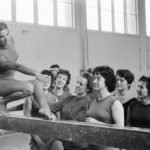
Have you ever wondered why gymnasts salute at the beginning and end of their routines? In this article, we explore the origins and significance of the gymnastics salute, from its historical roots to its modern-day importance in the sport.
Read on to discover the meaning behind this iconic gesture and how it reflects the values of gymnastics as a competitive sport.
What is a salute in gymnastics?
In gymnastics, a salute is a traditional gesture performed by athletes before and after their routines. It involves raising one arm or both arms above the head, with the hand(s) in a flat or fist position. The salute is a way for gymnasts to show respect and gratitude to the judges and the audience.
Why do gymnasts salute?
- Respect and Gratitude
One of the main reasons gymnasts salute is to show respect and gratitude to the judges and the audience. It is a way to acknowledge the importance of their presence and their role in the competition. By saluting, gymnasts are saying thank you for the opportunity to compete and for the judges’ attention and expertise.
- Preparation
The salute also serves as a way for gymnasts to prepare themselves mentally and physically for their routines. It is a moment of focus and concentration, during which they can block out distractions and center themselves.
- Symbol of Readiness
Another reason gymnasts salute is that it is a symbol of readiness. By raising their arms, they are signaling that they are ready to begin their routine. It is a clear indication to the judges and the audience that the athlete is about to perform.
- Tradition
Finally, saluting is a tradition that has been passed down in gymnastics for generations. It is a way to honor the sport’s history and to connect with the gymnasts who came before. By saluting, gymnasts are participating in a ritual that is both meaningful and symbolic.
How to perform the perfect gymnastics salute
It may seem like an insignificant part of the routine BUT performing a salute with elegance and a smile sets a great impression on the judges.
Traditionally female gymnasts lift both arms whereas male gymnasts only salute with one. However, in modern gymnastics, many male gymnasts will also lift both arms as well.
To perform a salute that will impress the judges:
- Lift your chin
- Extend your arms fully including your fingertips
- Step forward as you present
- Smile and make eye contact with the judges
- Salute with purpose, try to hide any nerves and show that you are focused and prepared

Where should a gymnast salute from?
There is some debate about when and where a gymnast should salute at the start of a floor exercise. Some gymnasts will salute from the side of the floor and then walk to their starting position ready to begin the routine. Other gymnasts will walk onto the floor first and salute from their starting position.
There is no deduction either way for any meet that I am aware of so the choice is one made by the coach or gymnast.
For other events such as Vault, Uneven Bars or Beam the salute is much more straightforward.
What if a gymnast forgets to salute?
Depending on the type and level of competition, there will often be a deduction imposed by the judges which will reduce the gymnast’s score. Typically this could be between 0.1 and 0.3 which doesn’t sound like much but if there are multiple judges and each one takes this amount it will add up to a significant amount.
At lower levels, judges may use their discretion and not impose the deduction.
Younger gymnasts are often nervous when they compete and it can mean they forget to salute because they are concentrating so hard on the routine! A good idea to help gymnasts mentally prepare is to have them perform their routine in a practice competition in front of other gymnasts and another coach who can act as the judge.
The added pressure in a ‘mock’ competition can help gymnasts build resilience and develop cues that they can use in the real thing, therefore, reducing the chance they will forget to salute!
Conclusion
In conclusion, the salute is an important part of gymnastics culture. It serves as a way for gymnasts to show respect and gratitude to the judges and the audience, to prepare themselves mentally and physically for their routines, and to signal their readiness to perform. It is also a tradition that connects gymnasts to the history of the sport.
- A Complete Guide to Gymnastics Hand Rips
 Are you tired of dealing with painful gymnastics rips on your hands from training? Look no further – this article offers a comprehensive approach to… Read more: A Complete Guide to Gymnastics Hand Rips
Are you tired of dealing with painful gymnastics rips on your hands from training? Look no further – this article offers a comprehensive approach to… Read more: A Complete Guide to Gymnastics Hand Rips - Is Gymnastics Dangerous? (Facts and Comparisons)
 Gymnastics is acknowledged as a highly technical and physically demanding sport. It inherently carries a risk of injury, which is why most coaches and clubs… Read more: Is Gymnastics Dangerous? (Facts and Comparisons)
Gymnastics is acknowledged as a highly technical and physically demanding sport. It inherently carries a risk of injury, which is why most coaches and clubs… Read more: Is Gymnastics Dangerous? (Facts and Comparisons) - The Fascinating Evolution of Gymnastics (History and Facts)
 Gymnastics is a sport that has been around for centuries and has evolved significantly throughout history. From its origins in ancient Greece to the modern-day… Read more: The Fascinating Evolution of Gymnastics (History and Facts)
Gymnastics is a sport that has been around for centuries and has evolved significantly throughout history. From its origins in ancient Greece to the modern-day… Read more: The Fascinating Evolution of Gymnastics (History and Facts) - The Ultimate Parallel Bars Skills List
 Parallel bars are one of the most challenging events in men’s gymnastics. Mastering the right moves first on parallel bars is essential to improving your… Read more: The Ultimate Parallel Bars Skills List
Parallel bars are one of the most challenging events in men’s gymnastics. Mastering the right moves first on parallel bars is essential to improving your… Read more: The Ultimate Parallel Bars Skills List - The Long-Term Effects of Gymnastics on the Body (A Complete Guide)
 While gymnastics can offer many benefits, such as improved fitness and self-confidence, many people also ask what are the Long-Term Effects of Gymnastics on the… Read more: The Long-Term Effects of Gymnastics on the Body (A Complete Guide)
While gymnastics can offer many benefits, such as improved fitness and self-confidence, many people also ask what are the Long-Term Effects of Gymnastics on the… Read more: The Long-Term Effects of Gymnastics on the Body (A Complete Guide) - What Age Does Competitive Gymnastics Start?
 Ever wondered what age does competitive gymnastics start? It’s well known that gymnasts start training at a young age to develop the skills and strength… Read more: What Age Does Competitive Gymnastics Start?
Ever wondered what age does competitive gymnastics start? It’s well known that gymnasts start training at a young age to develop the skills and strength… Read more: What Age Does Competitive Gymnastics Start?
